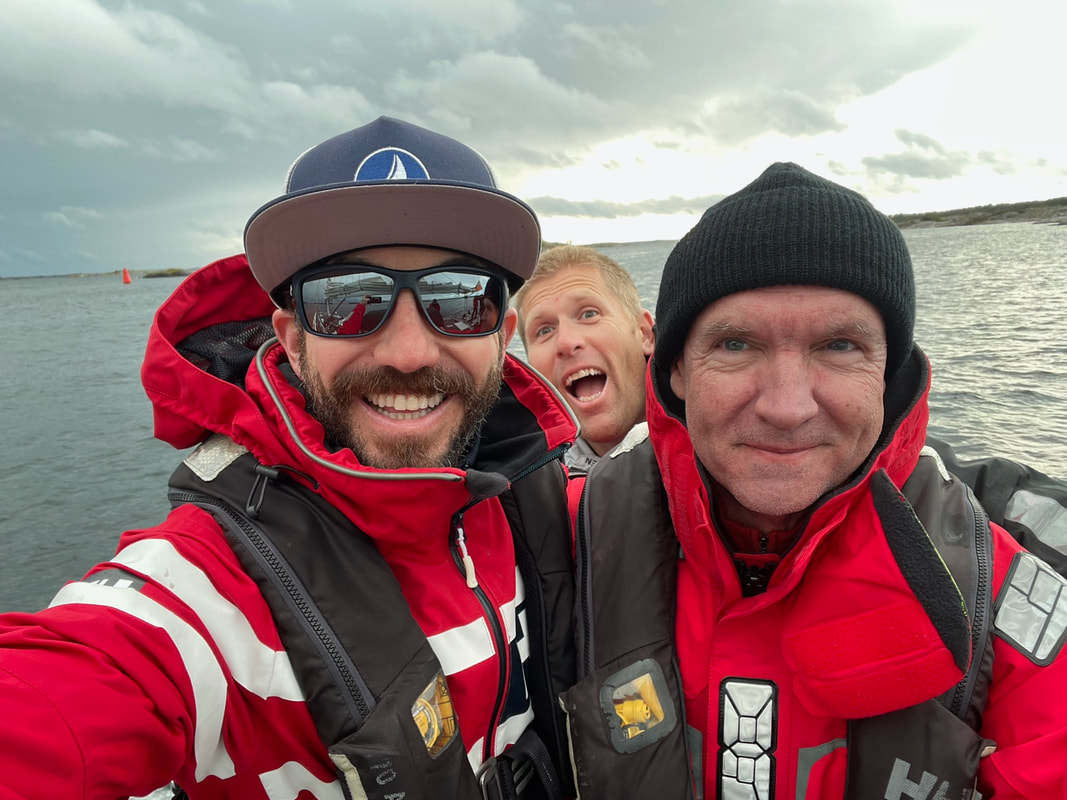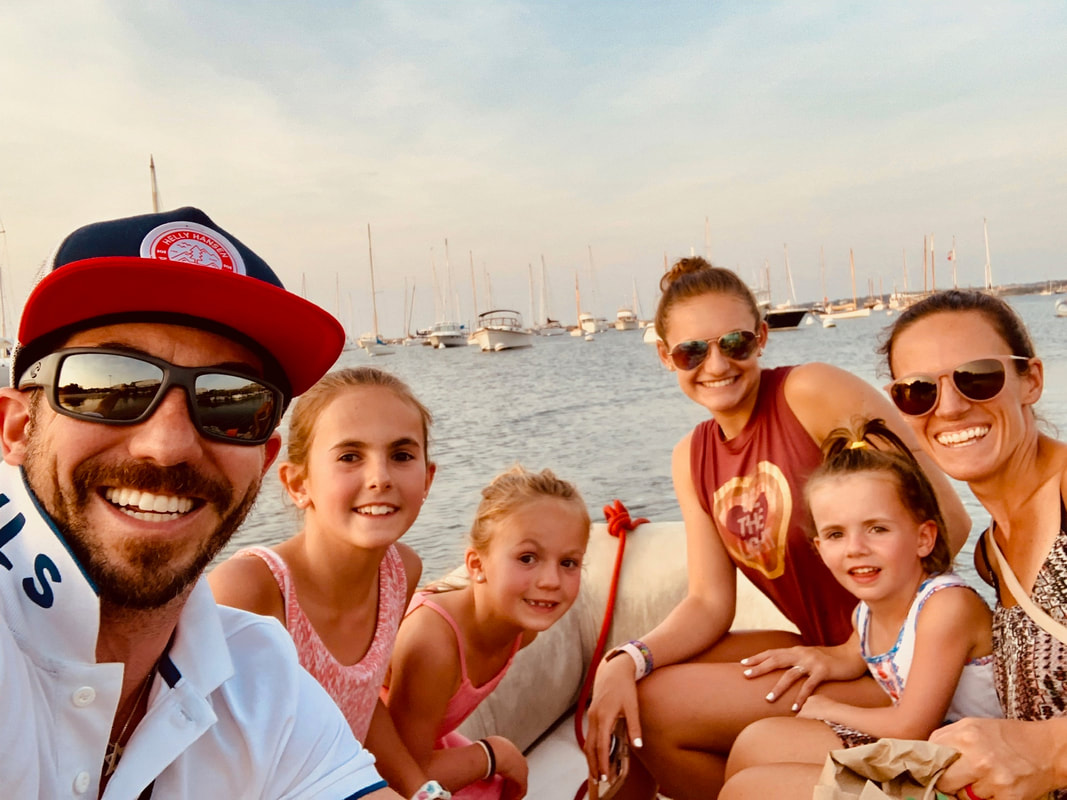Where is Royce? Click to Sail Along ⛵ Thursday morning, 10:58am, anchored in the Swedish Archipelago, approximately 4 hours away from hoisting the hook and heading out into the Baltic. We just finished a 90-minute safety briefing. I couldn’t be more confident in the boat, and more importantly, the crew’s ability to survive an emergency. As my safe return to the State’s seems to be everyone’s biggest concern, aside from Tara’s sanity in my absence, I thought it worthwhile before heading to sea to share what I learned this morning and why I’m feeling confident. Secondarily, I still have the goal of skippering my own boat and crew offshore one day, so plagiarizing a system that works for 59 North sounds intelligent, if mildly illegal. We’re in international waters, so pretty confident all laws are followed at my discretion. Emma is Andy’s first mate, which means she is responsible in redundancy to Andy for the safety of boat and crew, the two most important jobs of a captain/skipper. Around 9:30 this morning, after wrapping up a Euro breakfast of sliced cheese, tomatoes, cucumbers, toast and plum jam, with black coffee and tea of course, we settled into the cabin to begin the safety briefing. All of us are now represented by a number. There are 9 souls on board, so in the event of an emergency, where quick action is necessary or potential safety has been jeopardized, Emma begins an “accounting” for crew by shouting her number “1” loudly. In succession, we yell our number. Any gaps in the chain would indicate an injured or lost sailor and a bigger problem. Andy made it clear at the outset that if you go in the water offshore, you’re likely dead, so, and this cannot be overemphasized, do NOT go in the water. I am number 7. With each number, a job has been assigned via the “station bill," which indicates our job during an emergency:
Comms: There are a number of redundancies on board to reach the outside world. The ideal order of communication, though an emergency could throw order into chaos, would be to reach search and rescue via satellite phone and speak to them. They know and we know a connection has been made. The satellite phone is preprogrammed with numbers to relay stations in Denmark, Spain, UK and various other areas the boat might sail worldwide. Any of those stations could relay our message to another part of the world where rescue operations could be conducted. Inside the “Grab Bag”, a yellow dry bag with “GRAB” written in large permanent marker and located behind the navigation station in the cabin, there are two EPIRBs. Two for redundancy, an EPIRB (Emergency Position Indicating Radio Beacon) transmits a signal via satellite to worldwide rescue operations. As the acronym highlights, our position in real time is transmitted until the battery dies - 3 days. Medical Bags: There exist three medical bags on board. In total, they qualify to keep a crew safe to sail offshore in the remotest areas of the world. Emma has been trained to administer all medical care supported by the medical equipment. From simple bandages, to back splints, oxygen, Morphine, staple gun, splints, and antibiotics the three bags are filled with life-saving content I hope not to see again. I now have an answer to that nagging question around what to do in the middle of the Atlantic when you encounter an appendicitis? This hits close to home, as I am one of three in a six-person family that still has that useless organ. In my mind, it could go at any time, and Murphy’s Law of course guarantees that its failure will happen offshore in the middle of a sailing trip. I was ensured that the boat’s supply of antibiotics, administered via IV, would be sufficient to survive a 3,000 mile passage (cross an ocean), with time to spare, where one of my buddies at Intuitive could get me under the care of a cutting-edge surgical robot. Bring it, tummy ache. Grab Bags: In addition to the Comms, there are two heat-preserving hazmat suits that one would don after hopping into the life raft to avoid or slow hypothermia. Finally, there are a handful of various flares to deploy for signaling…or fleeting entertainment for a bored crew, drifting across the Pacific. After notifying the rescuer operation and deploying our EPIRBs, we would use a parachute flair (1,000 feet of loft before slowly drifting back to sea) to notify a ship we see on the horizon - can be viewed for 60-90 seconds from 30 miles. The second flare simply shoots a glowing burst into the air, like a firework. The third is a handheld flare that drips “liquid lava” according to Emma, so for the love of humanity, keep your arm out over the water so we don’t set fire to the life raft. Finally, when the helicopter is in close proximity, deploy the floating flare that emits 60 seconds of orange smoke that can be viewed during daylight or via infrared goggles at night. There was no discussion of food, but can assume that both rafts (we have two - noticing the redundancy pattern?) equipped with a supply of Pringle’s, Candy Corn, and bubble tape providing the most important life-sustaining elements - high fructose corn syrup and potassium all while cleverly packaged to provide hours of entertainment. I would also expect a handful of Maxim magazines and Home and Garden, located in your seat back pockets. One can’t lose their whits while drifting helplessly toward the former Soviet Bloc in late autumn. I clearly didn’t inquire, but assume some version of food exists in the raft along with the tubes of water that are clearly marked “drink in case of emergency”. Fixing the Problem: First, remember Andy’s first rule of survival - stay with the boat. Most “emergencies” on the water entail something that will not sink the boat. As such, hopping into a self-deploying 12-man life raft is literally a last ditch effort to survive. So, what constitutes an emergency: Fire - these could start because of an engine or an electrical mishap, but most likely an issue in the galley. We’re constantly making hot water for coffee and tea, cooking on the stove or baking cookies in the oven. Open flames and running lines of propane certainly need to be closely managed, but mistakes happen. There are 6 fire extinguishers clearly marked on board. We individually had to locate each one. Water, followed by a fire blanket under the sink, followed by the fire extinguisher are the order of operations there. Leak - Not surprisingly, a boat‘s very existence is to retard the intake of water. That battle is often lost in little skirmishes with the sea at various weak points. Like Napolean, exploiting a hole in his enemy’s line, the sea looks for “through hulls”, which are the holes in the hull of the boat below the waterline. These “ports” have various functions including to supply water to cool the engine, wash the dishes or flush the toilet. There are similar holes through which water must exit the cooled engine, washed dishes and, yes, soiled toilet. A laminated diagram of every through hull lives in the navigation table. Next to each of these holes, attached to the seacock which is a device to shut off the intake or output hose, there is a wooden plug. Pound one of those bad boys into the hole, and you’ll avoid a slow trip on a life raft to the little island of Elba where our Frenchman, having lost his skirmishes, spent his remaining days. If that method for stopping the leak fails, the first backup is the bilge pump. The bilge is the lowest point in the boat, where any water entering said boat eventually arrives. The bilge is checked by all crew coming off watch (every 4 hours). Slow leaks, or any indication of water entering the boat is commonly discovered first in the bilge. If water starts coming in too quickly, there is an engine-powered pump that Emma explained will remove water at the pace a fire-hose exhausts a fire. Sections of the boat are also divided by bulk-heads, which are water tight dividers that, when closed, shut off an area of the boat that is flooding. Yes, I understand the Titanic had them as well. But, we don’t plan to run into any icebergs. And, need I remind you, DiCaprio had an Ohio accent so one should question the entire legitimacy of the film. Life Raft: As mentioned, this really is our last resort. Having watched Titanic and read Dead Wake (Lusitania sinking), successfully boarding a life boat is nothing short of a small miracle. Picture a wild sea state, gale-force winds, precipitation, darkness, injuries, whistling rigging, and mass chaos whilst trying to leap into a moving target, burdened by your foul weather gear, deployed life jacket, and fear. Again, survival is achieved by staying with the boat. After all of those redundancies of communication and sustenance, the remaining question is how long before we’re out of luck? Didn’t I hear the batteries on the EPIRB die after a few days? How long will that rechargeable lithium battery on the sat phone last? Water in pouches, stored in a self-contained box of a deflated life-boat - how many days will that keep a crew of 9 hydrated? The answer to all of this: we have about 3 days of discovery, before the chance of survival plummets to Vegas-like odds of rescue. This all begs a question: Why would someone with any sense of self-preservation sign up for something as dangerous or feel more at ease following the aforementioned calamitous briefing? To that, I might ask when your family last discussed your fire escape route. Or thought through the dangers of driving up to Vail on a Saturday in light snow, before encountering the irrefutable perils you face once you arrive to ski. The point, we have a plan. We have able-bodied adults who I’ve discovered are fully functioning and a capable crew, despite our shared insensible sense of adventure. We have a well-tested skipper and first mate who I trust. And we have a boat who I sailed yesterday in 25 knot winds on a deep heel (picture a boat sailing at 15-20 degrees off it’s midline) and felt safe. So, I am well aware of the dangers and equally confident in our survival. We have a few last minute items to address and then will be heading offshore, but Keep tracking us on the Garmin. I’ll update the blog from Germany. Hegdo! (See ya, in Swedish)
0 Comments
Leave a Reply. |
We're the Zimmerman Family!
Home Base | Denver, CO A family of six that
LOVES to sail ! Follow our crew (Royce, Tara, Avery, Charley, Nora & Ruby) as we blog our sailing adventures Current Trip:
Set Sail 4.22.23 | Las Palmas - Across the Atlantic - Island of Antigua Previous Trips: Set Sail 9.22.21 | Sweden - Germany - United Kingdom Set Sail 7.18.19 | Newport, RI - Martha's Vineyard, MA - Nantucket, MA - & back! Thanks for reading !Previous Trip Posts:
April 2023
|


